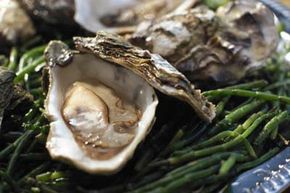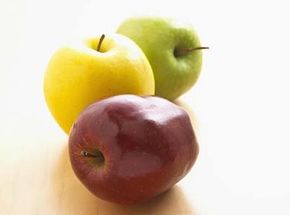Toxins may occur naturally, but some elements are added to foods during or after their production -- those are called additives, and they have a variety of uses and risks, including protecting and preserving food. However, pesticides are still considered by many to be a concern.
With all the research centered on fruits and vegetables these days, whole foods are finding a more mainstream audience than natural foods did in the 1960s and '70s. That was when additives reigned but were viewed with suspicion. Now, we know better. Some additives are helpful; some are harmful; some are harmful but too helpful to be banned.
For the most part, though, additives are not the major problem pesticides are. Here's the lowdown on some common additives.
Aluminum compounds. You see these in breads and baked goods as a leavening agent. It makes some people nervous, because of the reputed link between aluminum and Alzheimer's disease. However, that link is generally disregarded, and even if legitimate, you get much more aluminum from the environment, antacids, and buffered aspirin.
BHA & BHT. The preservatives BHA (butylated hydroxyanisole) and BHT (butylated hydroxytoluene) protect against rancidity in many foods, including powdered drink mixes, cereals, instant potatoes, and shortenings. The two are often vilified in the same breath, although only BHT has been linked to cancer. Hold on before you panic, though. Studies show it can both cause and prevent cancer in animals, depending on the circumstances. The effect in humans is only speculative; indeed, many scientists feel it is safe. There's actually no evidence that BHA causes cancer. In fact, just the opposite may be true: BHA may have some of the same benefits as antioxidant nutrients.
Food dyes. Talk about controversy! Some dyes seem perfectly safe, but others have an all-too-deserved tattered image. Maraschino cherries seem to bear the brunt of all this, as red dyes continually cause concern. The latest in red dye fiascoes was with red dye #3. In 1989, it was banned in cosmetics such as lipstick, but inexplicably not in foods. The FDA may yet take action on this front.
Yellow dye #5, also called tartrazine, is another infamous coloring. For most people it is harmless, but a small number of people are allergic to it. That's not surprising since it's related to salicylic acid, otherwise known as aspirin. Fortunately for those who are allergic, manufacturers must now clearly state its presence on the label, not just list it under "artificial colors."
Gums. These aren't the chewing variety, but natural-source gums, which are valued for their ability to thicken foods, prevent separation of ingredients, and improve the consistency of texture in foods like pudding, ice cream, salad dressings, and baked goods. Commonly used gums include carrageenan (from seaweed known as Irish Moss), guar gum, gum tragacanth, gum arabic, locust bean gum, and xanthan gum. They improve what the food industry likes to call "mouth feel." Many are not only safe, but as soluble fibers, are beneficial to health. Guar gum has been shown to lower blood cholesterol levels.
Modified food starch. This garnered a bad rap years ago when baby foods were castigated for containing it. It's not that it's a dangerous additive, or at least it's never been proved to be. The problem is when it takes the place of more nutritious ingredients. The chemically modified corn or tapioca starch is indigestible, so it has no calories, and babies need all the nutritious calories they can get. It prevents caking and clumping in puddings, spaghetti sauce, and toddler foods, but it is no longer included in baby foods.
Mono- and diglycerides. These are really fats (related to triglycerides) added to give a smoother texture to foods, but they rarely add many calories to a product because they're used in very small amounts.
Nitrites (sodium nitrite). This is one of the few additives known to be harmful. It's added to processed luncheon meats like bologna and salami, as well as to hot dogs, bacon, and other cured meats. It does have a useful purpose: preventing the growth of the deadly Clostridium botulinum bacteria (the organisms that cause botulism). It also gives these meats their characteristic pink color. The problem is that the nitrite converts to cancer-causing nitrosamines in your body. Manufacturers have cut back to half the amount of nitrites used. Still, it's best not to get any nitrites, or at the very least, be sure to have a vitamin C-containing food along with nitrite-containing foods, for antioxidant protection.
Sulfites (sodium sulfite, bisulfite, metabisulfite). These are not used as extensively as they were years ago, but are still used to prevent browning of foods such as some dried fruits; some dried and frozen potatoes; and some "fresh" shrimp (if the ice they are stored on has sulfites). Sulfites are added to wine in addition to the sulfite that is produced naturally in wine. For most people, sulfites are not a problem, but for those who are allergic to it, even a small amount can be life threatening. Since 1988, all foods that have added sulfites must be clearly labeled.
Additives can be harmful or helpful, depending on the usage and type, so they have generally gained acceptance over the past few decades. However, much controversy still surrounds pesticides. In the next section, learn about what these chemicals are used for, what concerns they pose and how to minimize risk.
This information is solely for informational purposes. IT IS NOT INTENDED TO PROVIDE MEDICAL ADVICE. Neither the Editors of Consumer Guide (R), Publications International, Ltd., the author nor publisher take responsibility for any possible consequences from any treatment, procedure, exercise, dietary modification, action or application of medication which results from reading or following the information contained in this information. The publication of this information does not constitute the practice of medicine, and this information does not replace the advice of your physician or other health care provider. Before undertaking any course of treatment, the reader must seek the advice of their physician or other health care provider.



